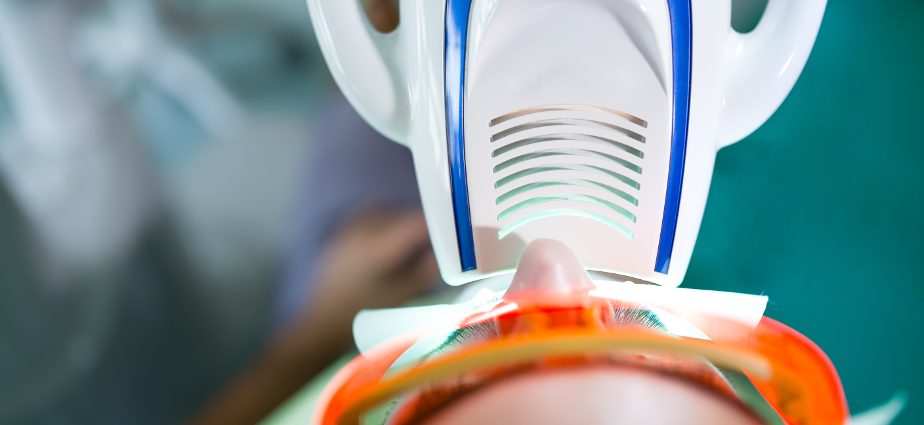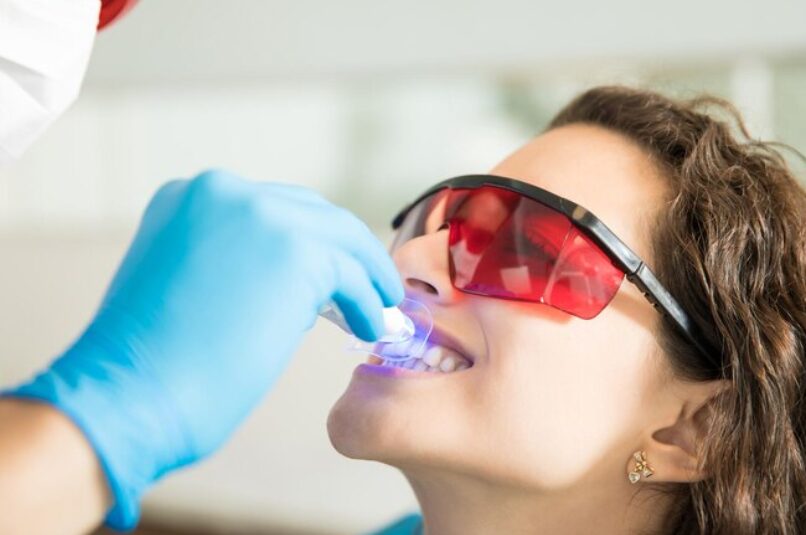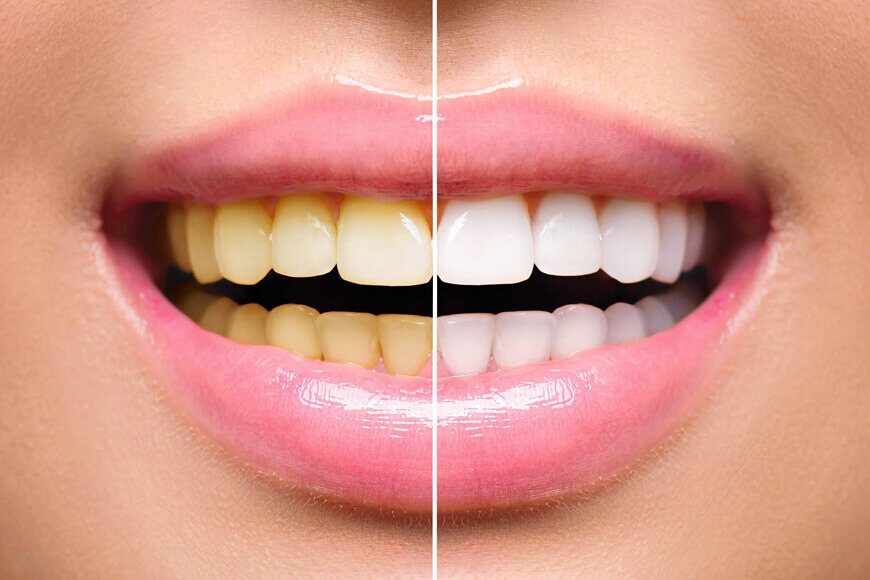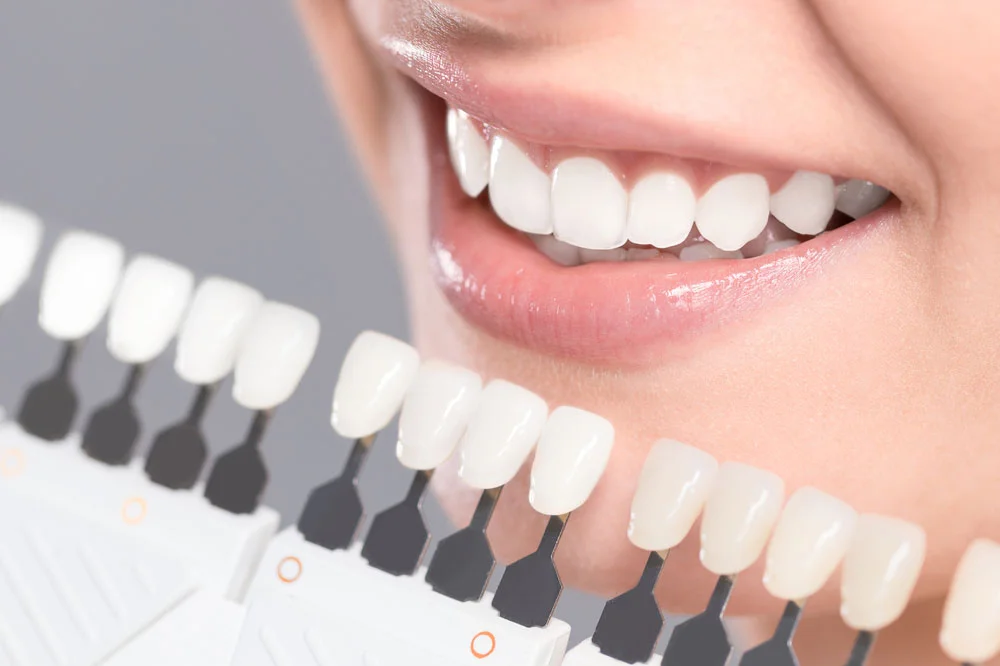In cosmetic dentistry, teeth whitening remains one of the most requested procedures. Many patients today are familiar with Zoom teeth whitening, a trusted system that delivers visible results within an hour. However, a newer approach, Nano teeth whitening, is gaining attention in the UAE for its gentler action, longer-lasting brightness, and reduced post-treatment sensitivity.
At Al Safwa Medical Center in Bani Yas, Abu Dhabi, our dental specialists perform both techniques using clinically approved materials under strict safety protocols. Understanding the difference between Nano whitening and Zoom whitening helps patients choose the most suitable option for their enamel type, stain depth, and oral health condition.
What is Nano teeth whitening?
Nano teeth whitening is an advanced cosmetic treatment that utilizes nanoparticle-based formulations to whiten teeth on a molecular level. These particles, often calcium phosphate or titanium dioxide in nano form, are small enough to penetrate the micro-tubules of the enamel, targeting intrinsic stains while reinforcing enamel structure.
At Al Safwa Medical Center, Nano whitening involves a multi-step clinical protocol:
- A detailed shade assessment and dental cleaning to remove surface plaque.
- Application of a nano-whitening gel containing biocompatible nanoparticles.
- Activation using a cold plasma or LED light source, allowing controlled whitening without heat.
- Enamel remineralization and fluoride sealing to restore smoothness and strength.
Unlike conventional whitening systems that rely heavily on high concentrations of hydrogen peroxide, Nano whitening uses lower peroxide levels combined with nanotechnology-based catalysts, minimizing irritation and tooth dehydration.
How does Zoom whitening work?

Zoom teeth whitening is a well-established in-office whitening system based on hydrogen peroxide gel activated by a specialized LED lamp. The process involves:
- Isolating the gums and lips to protect soft tissues.
- Applying a 25–35% hydrogen peroxide gel to the enamel surface.
- Exposing the teeth to the Zoom light for three to four cycles of 15 minutes each.
- Applying a post-treatment desensitizing agent.
The powerful oxidation process breaks down chromogenic molecules that cause discoloration, resulting in teeth that are typically 6–8 shades lighter after a single appointment.
Nano vs. Zoom whitening: detailed comparison
| Aspect | Nano Teeth Whitening | Zoom Teeth Whitening |
| Technology | Nanoparticle-based gel with biocompatible minerals | Hydrogen peroxide oxidation system |
| Activation | Cold plasma or LED, low heat emission | LED lamp with controlled heat exposure |
| Peroxide concentration | Low to moderate (6–12%) | High (25–35%) |
| Sensitivity level | Minimal to none | Moderate; often requires desensitizer |
| Enamel protection | Strengthens and remineralizes enamel | May cause temporary dehydration |
| Longevity | 8–12 months (with proper care) | 6–9 months |
| Suitable for | Sensitive teeth, long-term maintenance | Rapid results and event-based whitening |
| Session time | 45–60 minutes | 45–60 minutes |
| Follow-up | Annual or semiannual touch-up | Maintenance every 6–8 months |
Both systems produce clinically visible results, but Nano whitening focuses on long-term enamel health, while Zoom whitening prioritizes immediate brightness.
Which whitening option is safer for sensitive teeth?
Patients with dentin hypersensitivity, thin enamel, or exposed cervical margins often struggle with post-whitening discomfort. Nano whitening’s low-heat technology and reduced peroxide content make it clinically safer for sensitive teeth.
The nano-hydroxyapatite particles form a micro-layer over the dentin tubules, blocking fluid movement that causes pain signals. Moreover, the remineralizing phase helps repair microcracks, offering both cosmetic and protective effects.
In contrast, Zoom whitening may cause temporary sensitivity due to osmotic dehydration of enamel, though this effect typically resolves within 24 to 48 hours. At Al Safwa, our dentists apply desensitizing fluoride varnishes immediately after Zoom sessions to minimize discomfort.
How long do results last?
The longevity of teeth whitening depends on lifestyle, diet, and oral hygiene. On average:
- Nano whitening results last 8 to 12 months, maintaining a natural brightness due to the enamel-strengthening layer that resists pigment reattachment.
- Zoom whitening results last 6 to 9 months, as surface porosity may gradually allow stains to return faster if dietary habits are not controlled.
Patients are advised to avoid strong pigments (coffee, red wine, tobacco) for at least 48 hours post-treatment and to maintain professional cleanings every six months. Al Safwa specialists also provide custom whitening trays for at-home maintenance between visits.
Are the whitening ingredients safe for enamel?
Both systems are clinically approved and safe when performed under professional supervision. However, Nano whitening gels contain biomimetic minerals such as nano-hydroxyapatite and calcium carbonate that mimic natural enamel components, enhancing remineralization and surface gloss.
Zoom whitening gels rely on high-grade hydrogen peroxide stabilized with silica and glycerin. While effective, prolonged or excessive exposure without professional control can cause transient micro-porosity. This is why in-office monitoring at Al Safwa Medical Center is essential to ensure optimal exposure time and enamel safety.
Can Nano whitening treat deep intrinsic stains?

Yes, to a significant extent. Nano whitening’s mechanism allows nanoparticles to penetrate subsurface stains within the enamel prisms, targeting discoloration from:
- Aging and mineral loss
- Fluorosis or mild tetracycline staining
- Enamel hypomineralization
However, for severe tetracycline staining or non-vital tooth discoloration, combined approaches may be recommended, such as internal bleaching or veneers (Emax or Lumineers). Al Safwa’s cosmetic dentistry team often integrates Nano whitening as a preliminary phase before veneer placement to achieve color harmony across the smile line.
What is the typical post-treatment protocol?
After either Nano or Zoom whitening, patients at Al Safwa undergo a standardized post-whitening care protocol:
- Neutralization phase: The whitening agent is neutralized using a mild alkaline solution to stop oxidation.
- Fluoride varnish application: Rehydrates enamel and reduces post-operative sensitivity.
- Shade documentation: Final shade is recorded and compared for future maintenance.
- Post-care instructions: Avoid colored foods for 48 hours and maintain gentle brushing using non-abrasive toothpaste.
Our dental hygienists also provide tailored recommendations, including fluoride-free remineralizing pastes for patients undergoing frequent whitening.
Is there a risk of gum irritation?
Both systems are safe when performed correctly. Gum irritation may occur if whitening gel contacts soft tissue during application. At Al Safwa, our specialists use gingival isolation barriers and customized retractors to prevent leakage.
Nano whitening is generally less irritant because of its lower peroxide concentration and neutral pH. In Zoom whitening, pH-controlled gels and precise isolation minimize risk, but mild transient redness may occur in sensitive patients.
Combining Nano whitening with other aesthetic treatments
At Al Safwa Medical Center, whitening treatments are often combined with cosmetic bonding, veneers, or orthodontic finishing to complete smile makeovers. For example:
- Nano whitening followed by bonding: Enhances shade uniformity before composite restorations.
- Zoom whitening after Invisalign treatment: Final step to perfect post-alignment aesthetics.
- Laser gum contouring combined with whitening: Balances gum line exposure and tooth brightness.
These combination approaches are personalized based on enamel thickness, occlusion pattern, and overall aesthetic goals, ensuring optimal harmony in both color and shape.
The science behind Nano whitening materials
Nano whitening formulations are based on nanotechnology principles where particle size and surface reactivity enhance diffusion into the enamel’s interprismatic space. The average particle diameter ranges between 20–80 nanometers, allowing effective contact with organic and inorganic enamel components.
Key active materials include:
- Nano-hydroxyapatite (Ca₁₀(PO₄)₆(OH)₂): Reconstructs micro-defects and increases enamel microhardness.
- Nano titanium dioxide (TiO₂): Acts as a photocatalyst under LED exposure, accelerating stain oxidation.
- Calcium carbonate nanospheres: Smooth the enamel surface and improve light reflectivity for higher brightness index.
Practical considerations before whitening
Before any whitening session, professional dental evaluation is mandatory to identify:
- Caries or leaking restorations
- Gum inflammation or periodontal pockets
- Enamel cracks or exposed dentin
At Al Safwa Medical Center, no whitening is performed before treating existing decay or infection. This ensures long-term success and prevents complications such as chemical irritation or post-treatment pain.
Patients are also advised to undergo scaling and polishing one week before whitening to ensure optimal gel contact and uniform shade change.
Maintenance after whitening

To maintain brightness, we recommend:
- Using toothpaste with nano-hydroxyapatite or potassium nitrate to reduce sensitivity.
- Avoiding chromogenic beverages for at least 48 hours.
- Scheduling touch-up whitening every 8–12 months for Nano whitening and every 6 months for Zoom.
- Undergoing regular check-ups and professional cleanings twice a year.
Lifestyle changes such as quitting smoking and moderating coffee intake significantly extend whitening longevity.
Choosing the right whitening system at Al Safwa Medical Center
Selecting between Nano and Zoom whitening depends on your enamel condition, sensitivity level, and aesthetic goals.
Patients seeking sustainable, enamel-safe whitening with minimal sensitivity often benefit from Nano whitening. Those preferring immediate results for a specific occasion typically choose Zoom whitening.
During your consultation, Al Safwa’s dental experts analyze your tooth structure, existing restorations, and oral hygiene to determine the most effective and biologically safe whitening plan.
Conclusion
Both Nano teeth whitening and Zoom whitening provide impressive cosmetic outcomes when performed by experienced clinicians. The main difference lies in mechanism, sensitivity, and enamel response.
Nano whitening offers a biomimetic, long-term solution for patients prioritizing enamel protection, while Zoom whitening remains the go-to choice for rapid brightening under professional control.
To learn more about which treatment best suits your smile goals, visit www.alsafwamedical.ae or schedule a consultation at Al Safwa Medical Center – Bani Yas, Abu Dhabi for a personalized whitening assessment.

